CubieTruck Metal Case is a kit comprised of CubieTruck (aka CubieBoard 3), a 128GB SSD, a 5,300 mAh battery, a power adapter, and various cables. In case you are not familiar with CubieTruck, it’s a development board by CubieTech, based on Allwinner A20 dual core ARM Cortex A7 processor with 2GB RAM, 8GB NAND flash, a SATA connector, HDMI & VGA outputs, Gigabit Ethernet, 2 USB host ports, and a mini USB OTG port. CubieTech decided to sent me a kit, as it was featured on CNX Software, and today, I’ll show what’s exactly is inside the kit since the product description is not 100% clear. I’ve been told it’s pre-installed with Lubuntu, so in a separate post next week, I’ll try Linux, report on the SSD performance, and check the battery UPS function, and possibly life on a charge.
CubieTruck Metal Case Unboxing
I’ve received the kit in a cardboard box by Fedex. It’s mostly a blank box so I skipped the picture. Contrary to what I believed, the kit comes mostly pre-assembled.
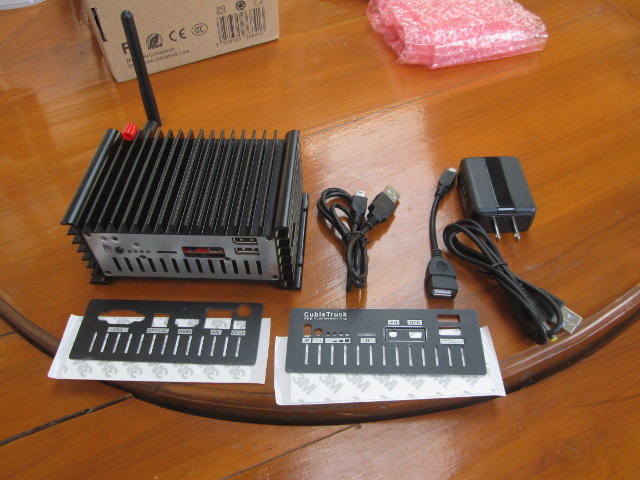
CubieTruck board, the 128GB SSD, and the battery are already fitted into the metallic enclosure. Extra accessories include a Wi-Fi antenna, a mini USB to USB cable, an OTG adapter, a 5V/2.5A power supply with its corresponding USB cable, front and rear panels with ports’ description, and 3M stickers to tape then against the case.
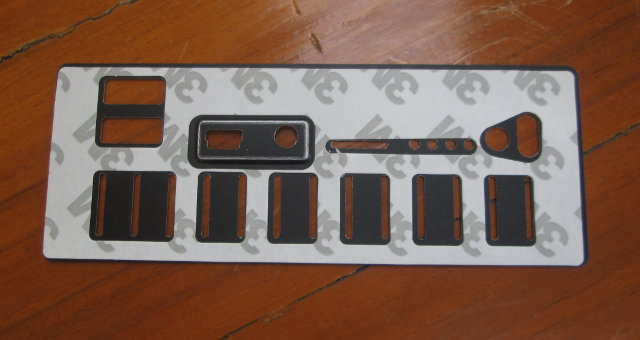
So you just need to peel the 3M sticker, tape it on the back of the metallic plate, and remove the bits hiding the connector by pushing with a thin object. I simply used my cutter. Then remove the second layer, and stick it on the front or rear panel. If you plan to open the box first, to access the headers, you should delay this step since you’ll have to take out the plates to open the device.
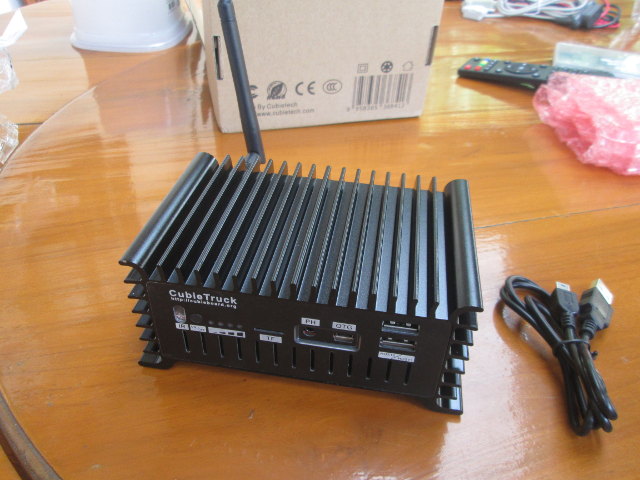
So on the front you’ve got the IR receiver, the power button, four LEDs (for volume?), a micro SD card slot, an headphone jack, a mini USB OTG port, and two USB 2.0 host ports.
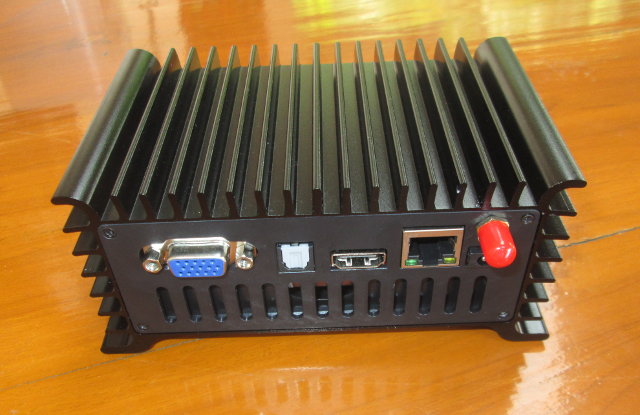 The VGA port, optical S/PDIF, HDMI port, Gigabit Ethernet port, power barrel, and Wi-FI antenna connector can be found on the rear panel.
The VGA port, optical S/PDIF, HDMI port, Gigabit Ethernet port, power barrel, and Wi-FI antenna connector can be found on the rear panel.
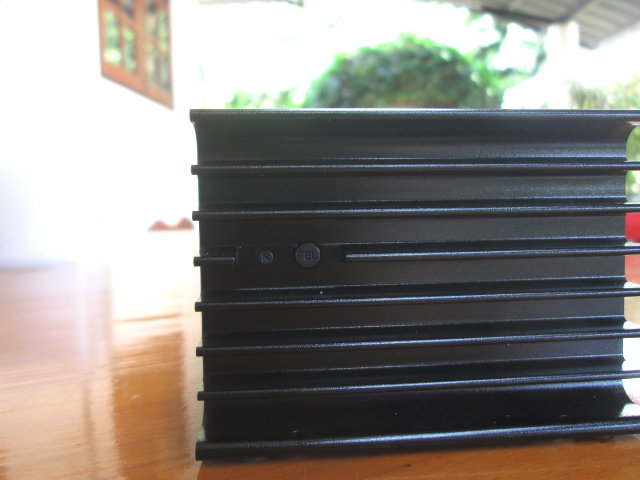 There are also two button on the side of the device for Reset (small), and FEL mode (big) that allows you to update the firmware.
There are also two button on the side of the device for Reset (small), and FEL mode (big) that allows you to update the firmware.
CubieTruck Metal Case Kit Internals
I’ve also disassembled the kit to see what’s inside. You have to remove 10 screws in total on the front and rear panels to be able to take out the board.
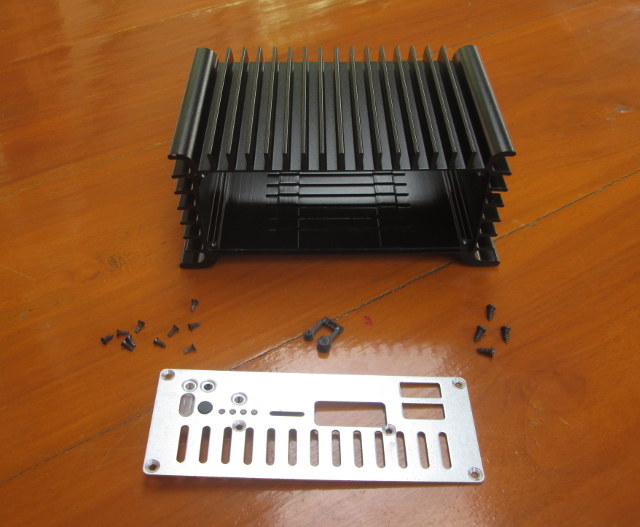
The Board/SSD/Battery then slide easily out of the metallic enclosure.
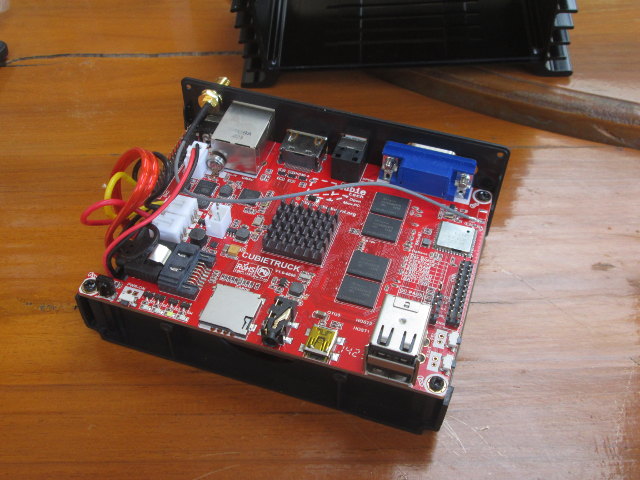
Untighten four more screws to remove the board and reveal the SSD.
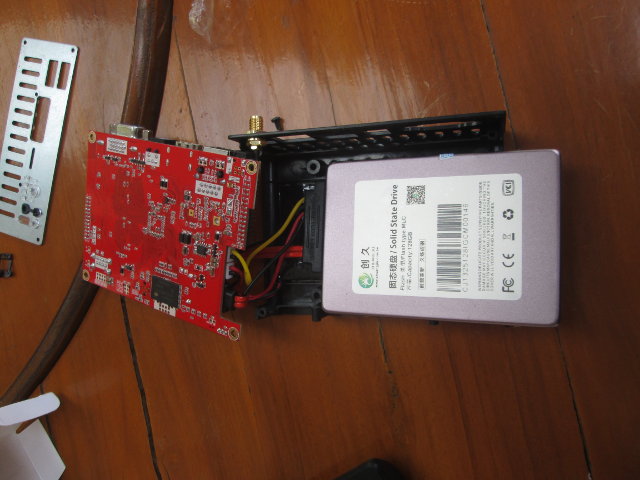
Contrary to the KingSpec C3000.6-M128 SSD found in the installation instructions, I got a 128GB CHUANG JIU SSD. There’s no model number, just a serial number. I could not find this SSD anywhere on the net, albeit Chuang Jiu S300-J8-128GB appears to have similar specs (128GB / MLC), but it does not look the same at all. Anyway that means the brand of SSD found in the kit may vary. The SSD also makes some noise when I move it around, which I find a little odd and worrying.
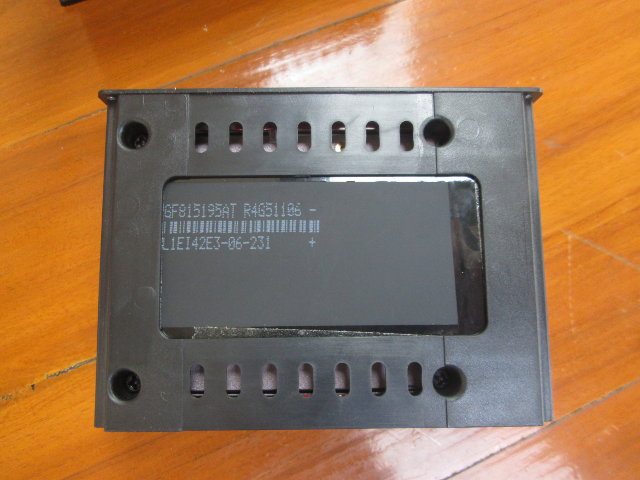
If I remove three more screws use to attach the SSD to the enclosure, I can see the battery, but the top side is pure black. Some markings are located on the bottom of the battery bu nothing indicates capacity.
You can also watch the video below where I unbox the kit, and disassemble it live.
Availability and Price
CubieTruck Metal Case kit can be purchased for $169 on Seeedstudio (In Stock next week, e.g. Nov 24), or 149 Euros exc. VAT on EmbeddedComputer.nl. I found the price very good, but just to make sure, I’ve decided to check the price it would cost to get a similar kit by buying individual components:
- Cubieboard3 / CubieTruck with cables – $89 on Miniand
- 5,300 mAh battery for CubieTruck – 18.99 on Amazon US
- Metal Case for CubieTruck Only – $32.99 on Ebay
- Low cost 128GB SSD – KingSpec C3000.6-M128 for $69.34 on Ebay. I could not find any Chuang Jiu SSD for sale.
- 5V/2.5A Power Supply – $6 on Aliexpress
The total would be $216.32 + some shipping, and if you take out CubieBoard3 from the kit, it would be $127.37 + possibly some shipping. So with this kit, you save about $50 compared to doing it on your own,and this confirms it’s good value provided you need a rugged metal enclosure, a battery, and a SSD for storage.
Next step is to boot it up, check current support in Linux including 2D/3D acceleration, video playback, flash support, and SSD performance, as well as battery behaviour and life.

Jean-Luc started CNX Software in 2010 as a part-time endeavor, before quitting his job as a software engineering manager, and starting to write daily news, and reviews full time later in 2011.
Support CNX Software! Donate via cryptocurrencies, become a Patron on Patreon, or purchase goods on Amazon or Aliexpress




